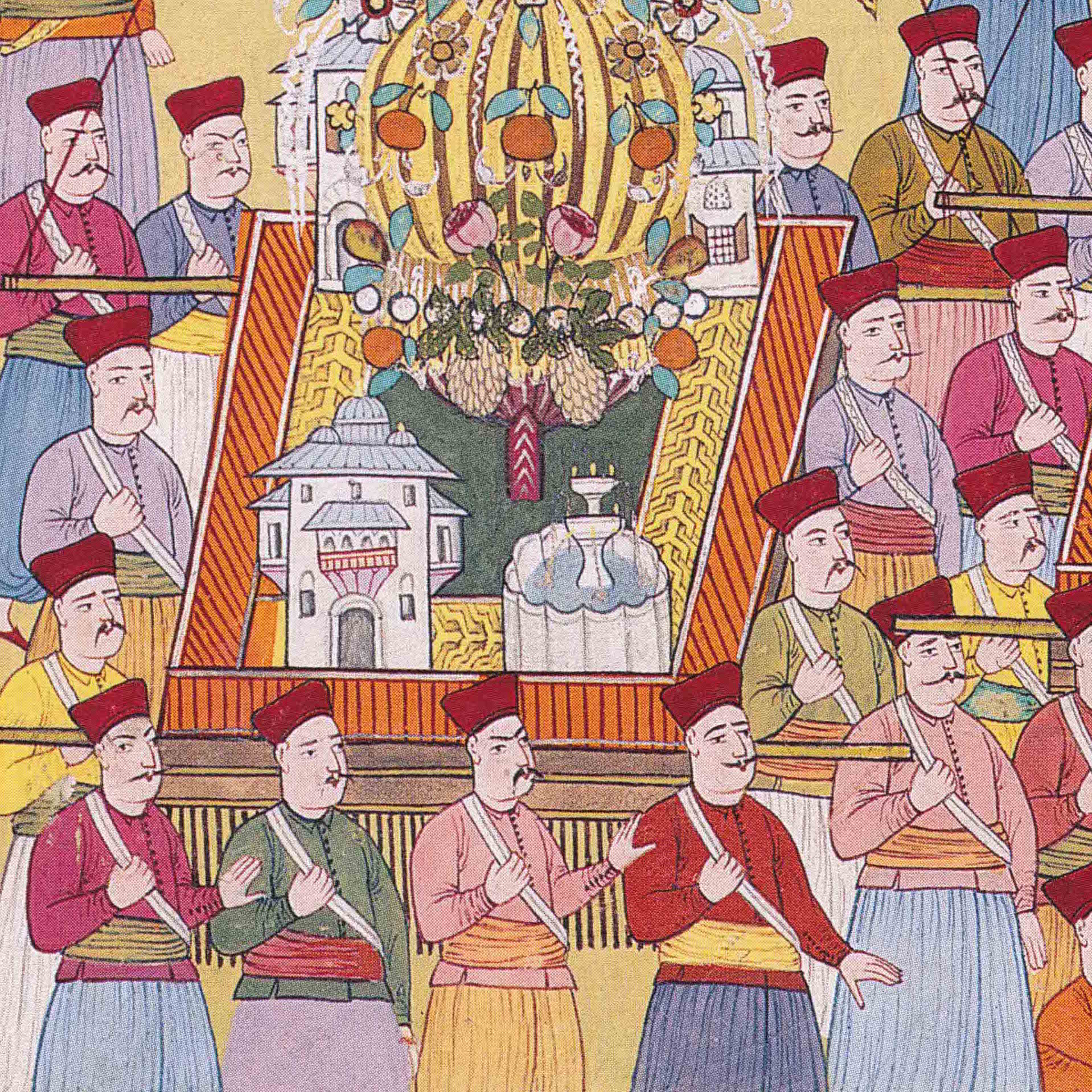Exploring the carnivalesque in the Persian and Turkish miniature traditions
Translated from the Turkish by Eda Ata
Undoubtedly, the Russian philosopher Mikhail Bakhtin (1895 – 1975) is often the first person to come to mind when discussing the topic of the carnival. His reputation aside, what is interesting about Bakhtin’s analysis of the phenomenon of the carnival is the link he established between it as a literary genre and a socio-historical structure. According to Bakhtin, assuming carnivals to be ‘masked balls’ of the modern era in the over-simplified, extravagant context of theatric carnivals is erroneous. In order to properly understand the carnival, it is necessary to examine its origins and zeniths; in other words, one needs to reflect on the phenomenon in its various stages throughout antiquity, the Middle Ages, and the Renaissance.
To Bakhtin, the carnival was a world that dispelled people’s fears, created bridges between the individual and the world at large, and familiraised people with one another. Bakhtin’s world was the polar opposite of unilateral formality and dogma, and all things standing in the way of evolution and change that try to preserve the status quo. Arguing that the carnival had the potential to save people from such rigidity, Bakhtin emphasised at the same time that the ideal form of the spectacle was devoid of any nihilism, frivolousness, or vulgar bohemian individualism, even though it may have appeared to some at the time to be purely nonchalant.
Bakhtin defined the carnival as a ‘harmonising’ show, replete with pomp. Being highly complex and changeable, the carnival as a form has exhibited various nuances, depending on the time period, audiences, and preferred forms of entertainment. Interwoven with symbolic forms, the carnival incorporates diversity as both a public and private act. To Bakhtin, the carnival was something to be experienced, rather than watched, and he often referred to what he called the ‘carnivalesque life’. Bakhtin’s carnival was a ceremony without a stage and any form of division between actors and spectators. All were active participants; the carnival could not be watched, or even performed: its participants lived in it.
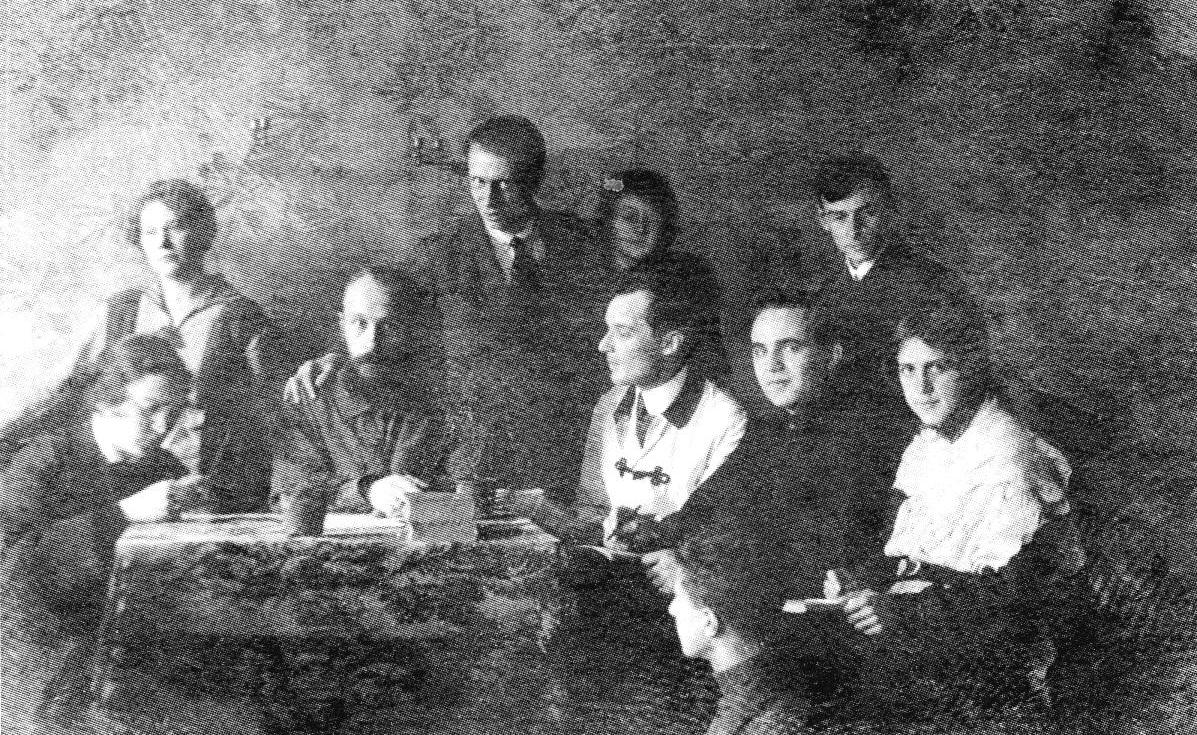
Mikhail Bakhtin (third from left) in Russia; date and photographer unknown
As with literature, Bakhtin’s carnival ‘theory’ can influence how one perceives visual art, as well as aid in seeing things from a different perspective, especially in the case of miniatures in the Persian and Turkish traditions.
Hip to be Square
Bakhtin argued that the main locus for carnivalesque acts was the square, as well as the streets around it. Doubtlessly, even the house is invaded by the carnival as well. The carnival knows no stage or spotlight, the square being the only main attraction, which belongs to all. In the Persian and Turkish miniature traditions, the main focus is also, as with Bakhtin’s carnival, the square. However, squares in miniatures can be classified into two different categories: the first is the real, which allows people to come together during wars or celebrations, whereas the second is the state of becoming a square, which stems from the unique quality of miniatures.
In the first category, squares in miniatures depict scenes of festivals, athletics, war, and plunder, all of which bear a striking similarity to the spirit of the carnival. In Ottoman Turkey, festivals were held to celebrate marriages, birthdays, the circumcision ceremonies of the sons of sultans, accessions, and conquests, as well as defeats (such that people might forget about them). Held in squares, such festivals were open to the public – even prisoners – without any sort of discrimination, and even behaviour normally considered inappropriate was permitted. Serving as a kind of security measure within a rigid society, festivals in Ottoman times forged bridges among different layers of society, and helped bring the sultan and commoners closer together.
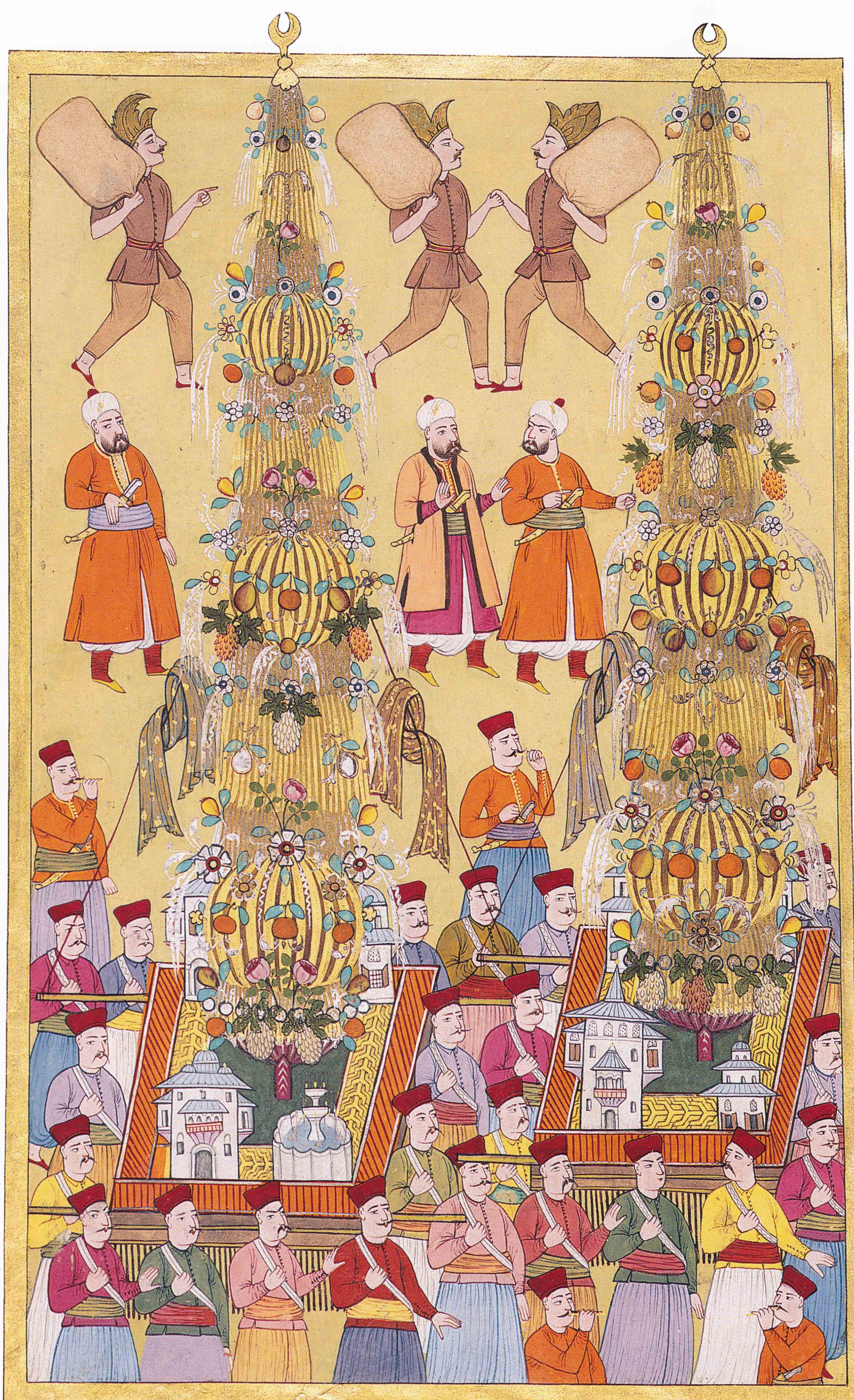
Nahils in the Festival of 1720 (From the Surname-i Vehbi; sourced from Osmanlı Tasvir Sanatları)
In these festivals – which typically lasted for weeks, all throughout the day and night – vendors endorsed their wares, and acrobats, lion tamers, magicians, jesters, musicians, and dancers performed incredible feats; accompanied by rockets and fireworks, stranded ships were used to perform war games, and sculptures made of candies (e.g. candy ‘gardens’) called nahil were exhibited. In a miniature entitled Parade of Glassmakers, the circumcision feast of Mehmet (son of Sultan Murat II), which lasted 52 days, is depicted. On the first page of this two-fold miniature situated in a horse stable, stacks of glass can be seen placed around an oven on an apparatus. On the second can be observed glassmakers walking and exhibiting various creations, such as vases and carafes. Just as with carnivals, what is prominent in such miniatures is the fact that events occur in a realm half fantasy, and half reality. The oven on the cart signifies a sense of playfulness, while the trials of the glassmakers add a sense of truth. The glassmakers here are both playing a ‘game’, while literally living in it at the same time.
It is well known that perspective was not applied in the execution of miniatures. Rather, the artists formed their own ‘rules’. The sultan observing the glassmakers was drawn larger than the people sitting in front, despite sitting far away. Considering this point of view, one can observe that perspective in miniatures does not depend on actualities, but social hierarchy. The size of a figure is determined by the importance he or she holds, not by proximity. Likewise, whatever details were to be depicted in a miniature were determined in a case-by-case basis. For instance, in events taking place in palaces, estates, or tents, it is possible to view the outside as well as the inside of the interiors. The mosaics on the walls, carpets, and other various objects, in addition to trees and florae, were all painted very meticulously.
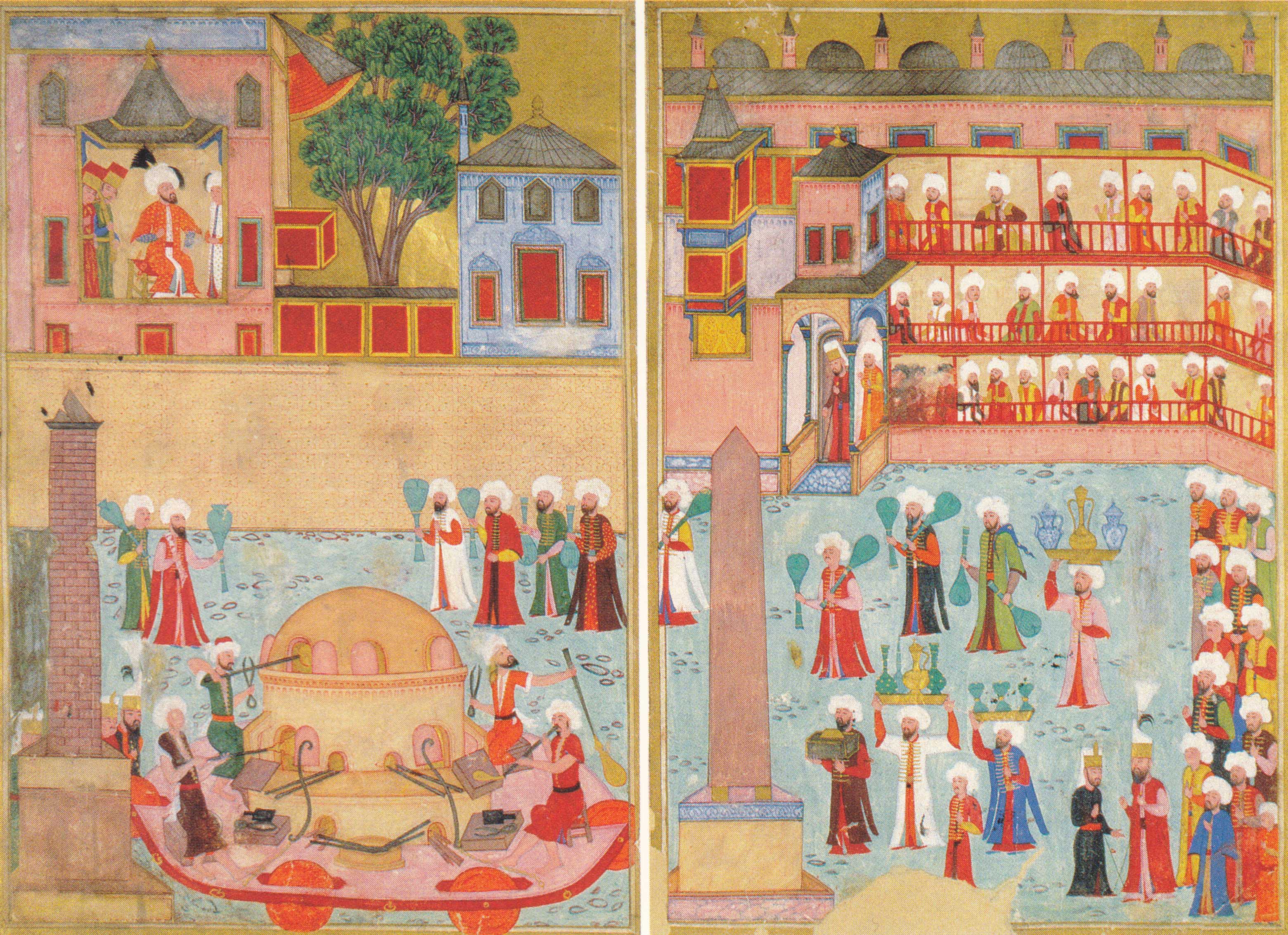
Parade of Glassmakers by Intizami, from the Surname-i Hümayun (c. 1587; sourced from Osmanlı Resim Sanatı)
Each detail of these miniatures had to be documented or depicted in such a way that ‘obstacles’ such as mountains and walls flowed forward in a transparent fashion. This approach integrated interior and exterior spaces, transforming both into a unified stage simultaneously. Miniature stages became spacious squares, all intertwined in terms of time and space. The appearance of each element at the same time makes the space appear larger, more spacious and glorious, and infinite. In this way, the world of miniatures becomes a wide square, and in turn, the square a carnival.
The carnival unites, connects, and combines the sacred with the earthly, the holy with the profane, the significant with the trite, and the sage with the fool – and much of the same can be said with respect to the mésalliances inherent in the Persian and Turkish miniature traditions
In a two-page miniature entitled The Assembly of Süleyman and Belkis, one can observe a prime example of an indoor space transforming into a square. In one of the pages, the Prophet Solomon (Süleyman) and Balqis (Belkis), the Queen of Sheba, sit on a throne. Consisting of strips, the pictures show birds and angels in the upper corners. In each strip, people of various professions can be seen, as can demons, fairies, giants, constellations, stars, and other various creatures. The gathering of such different beings and the great mass they converge to form can be said to evoke the quality of a carnival.
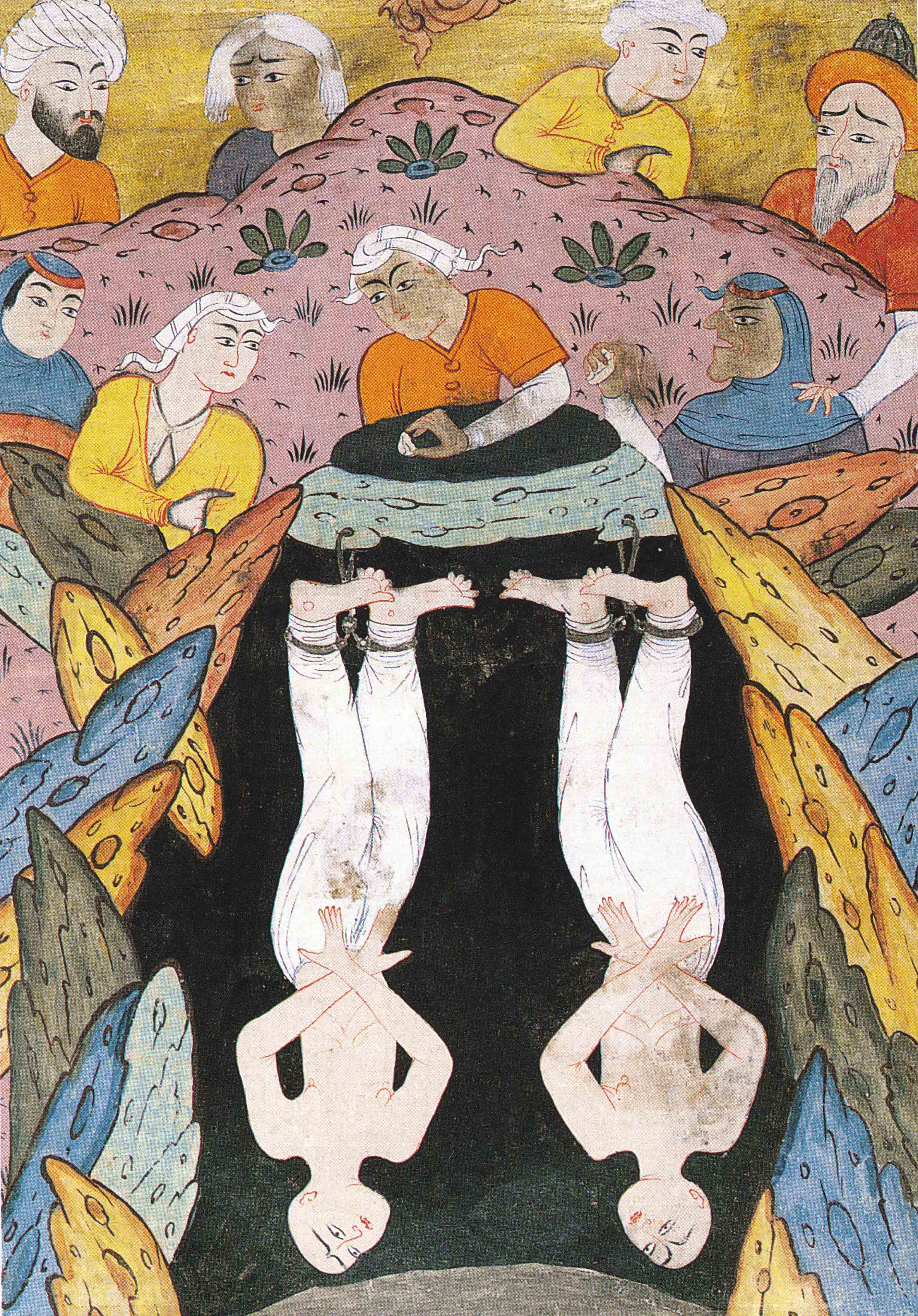
Harut and Marut in Their Forever Well, from the Falname (c. 1703; sourced from Minyatürlerle Osmanlı-İslam Mitologyası)
In both the example of the aforesaid miniature and the ‘real’ squares turning into carnivals, it is necessary to emphasise that the most important factor creating the ‘carnivalesque’ is the idea of heterogeneous figures coming together to create a storyline. According to Bakhtin, all elements isolated and lost in a hierarchic world become drawn into, and intermingle in the world of the carnival. The carnival unites, connects, and combines the sacred with the earthly, the holy with the profane, the significant with the trite, and the sage with the fool – and much of the same can be said with respect to the mésalliances inherent in the Persian and Turkish miniature traditions.
In many miniatures can be found depictions of punishment for violating sacred values. In one piece, the angels Harut and Marut are seen hanging upside down by their feet until Judgment Day. As well, the Album of Ahmet I provides jarring and scathing illustrations, particularly in the Hamse (Quintet) manuscript by Nevizade Atayi. Atayi freely made use of idioms and obscenities, and his humorous stories were laden with a kind of social criticism. In the background of the miniature entitled Street Scene: A Voyeur is Beaten Up During Tasbaz’s Show, a magician revealing plates and other sundry items under his white robes is depicted, while in the forefront of the miniature, a man who has sexually harassed a young boy is being lynched by a crowd. The assailant’s member is erect, and the illustration altogether is typically carnivalesque.
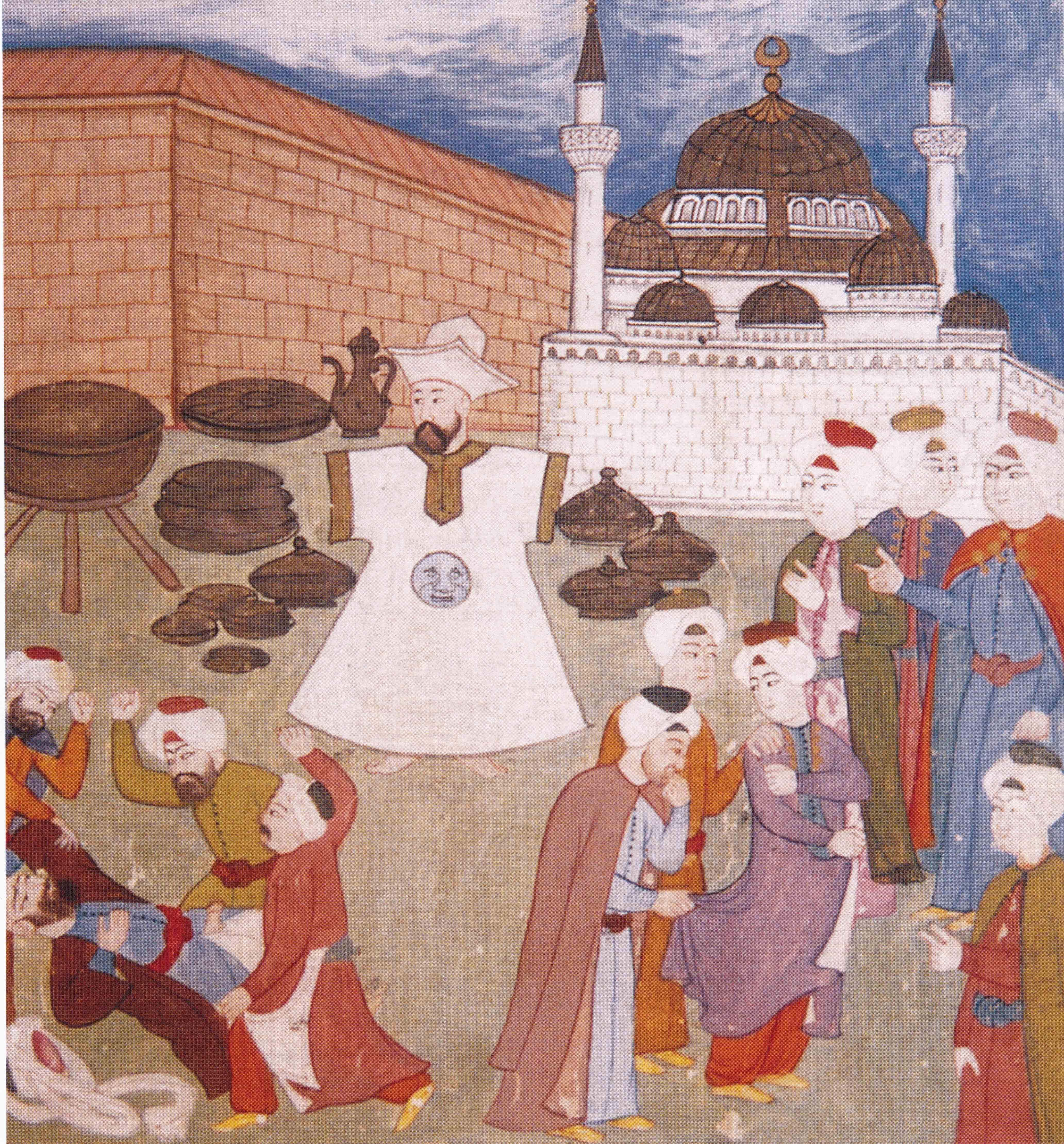
Street Scene: A Voyeur is Beaten Up During Tasbaz’s Show, from the Hamse-i Hatayi (source: Osmanlı Tasvir Sanatları)
Dynamic Duos
Miniatures also possess a dual, two-sided nature, similar to that of the carnival. In miniatures, in order to emphasise certain aspects of people or objects, an image representing the exact opposite was drawn. For example, in miniatures recounting episodes from the life of the Prophet Muhammad, the holiness of the Prophet was accentuated by the use of worldly people and figures. Likewise, in miniatures featuring monarchs and other rulers, weakness highlighted power, disobedience command, failure triumph, and disorder order.
The central ritualistic act of the carnival can be said to be the faux coronation and deposition of the carnival ‘king’. Defining this as dualistic, Bakhtin stated that these gestures occur in almost all carnivals. Such acts can be viewed as real in miniatures, and signify a sense of change and renewal. A miniature entitled The Enthronement of Süleyman the Magnificent is a case in point. After hearing about his father’s death, Süleyman arrived in Istanbul from Manisa (where he served as a governor) and ascended the golden throne in front of the Babüssaade (Gate of Felicity) at the Topkapı Palace. As part of the ceremony, the Şeyhülislam (Chief Cleric) and the Grand Vizier, along with other viziers and various governors were present in their assigned places. On the first page of the miniature, people of varying ages and professions chatter excitedly in small groups, in a chaotic and disorganised setting. On the second page, however, the figures sitting closer to the sultan are observing rules of propriety and decorum as demanded by the etiquette of the ceremony. It can be inferred that, similar to the miniature on the first page, in the second, the topic being discussed using exaggerated gestures is the enthronement of the new sultan, and the death of the first. There is a state of renewal brought about by the change, yet the new situation has also generated an atmosphere of ambiguity and crisis.
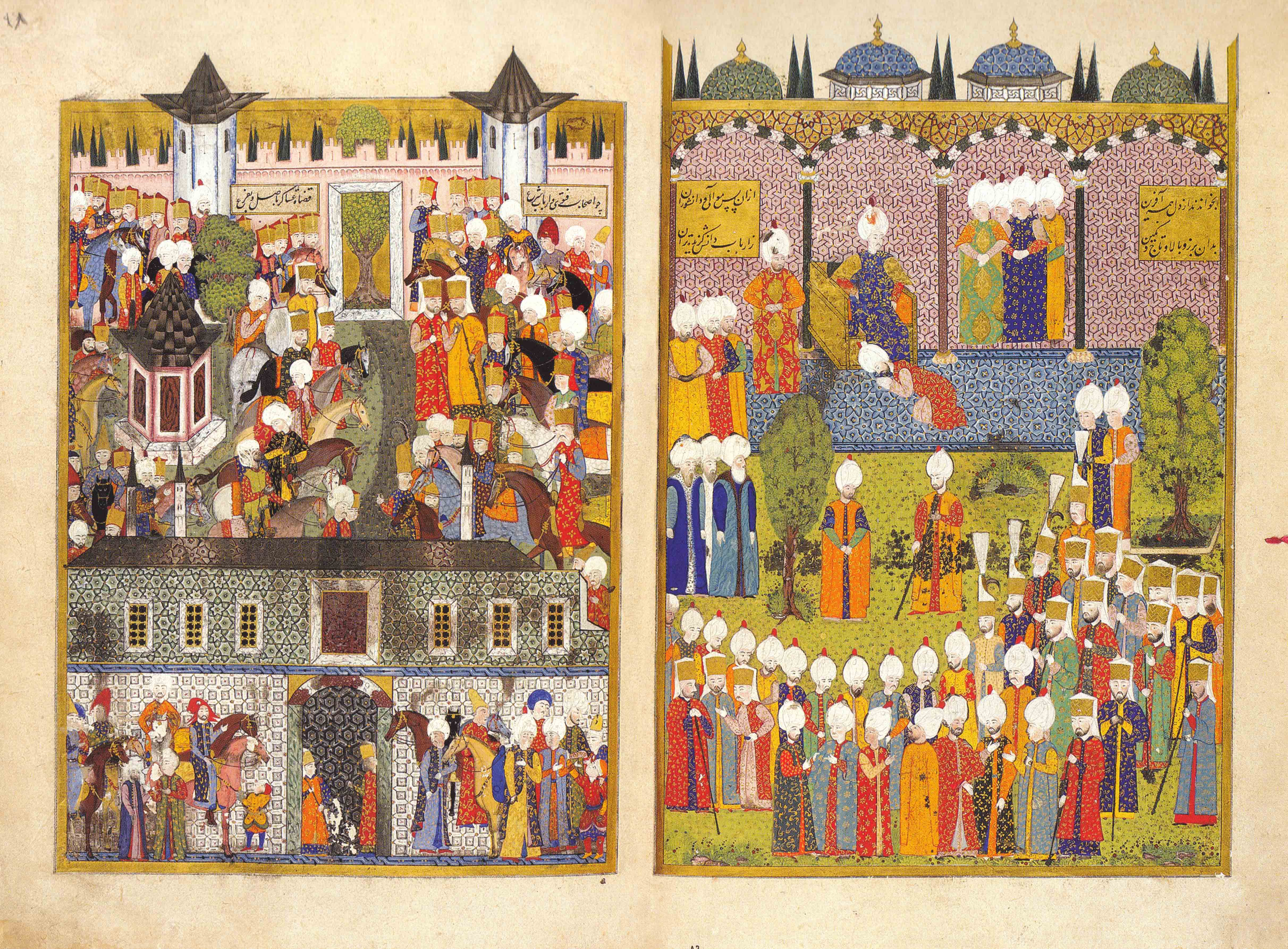
The Enthronement of Süleyman the Magnificent, from the Süleymanname (1558; sourced from Osmanlı Resim Sanatı)
The ritual of deposition according to Bakhtin is inherent to the basic understanding of the carnivalesque. The carnival is a festival wherein all dies, and all is renewed. The coronation and deposition of kings is dualistic in Bakthin’s carnival, as coronations often follow depositions, just as death follows birth, and birth follows death. A miniature in which this concept can be observed clearly is Murat I Rests After a Triumph. Here, carnivalesque acts of change and renewal can be observed in the aftermath of a war. One can observe both the change in power caused by the triumph of Murat, as well as witness the renewal brought by birth after death. An expected crowd of soldiers can be seen, whereas there is only one civilian: a woman carrying a baby in her arms. From one perspective, her presence here can be interpreted as symbolising Murat I’s treatment of women and children during battle. From another, however, she can be seen as a figure of renewal, in the carnivalesque sense: after the death and destruction, there appears a newborn baby; and, having won the war, a new government has come into power. There is no final ‘point’ either here, or in Bakhtin’s carnival: all endings simply serve as new beginnings. To paraphrase Bakhtin, carnivals are where a pregnant death gives birth, and wombs turn into graves.
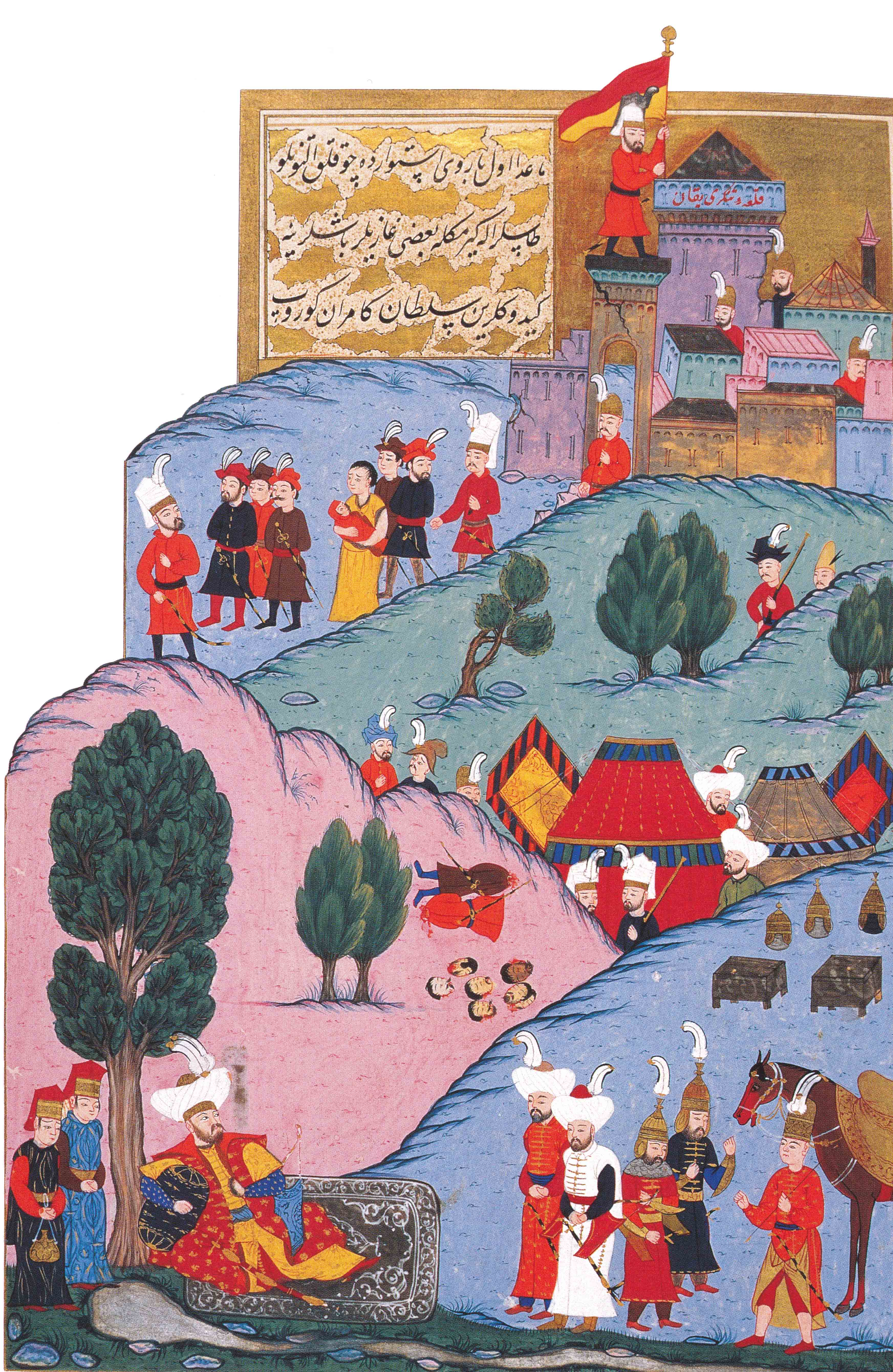
Murat I Rests After a Triumph, from the Hünername (1523; sourced from Osmanlı Tasvir Sanatları)
Weird and Wonderful
Another element integral to both the carnival and the miniature tradition is that of eccentricity. In a miniature by the name of Hacova War, the array of figures seems to possess an opposite sense of perspective: figures become larger from back to front, as opposed to the other way around. The figures are disproportionately inflated, and as such, the tents seem tiny in comparison to people and other buildings, giving the miniature a carnivalesque air. As well, even objects here have been employed in ‘reverse’. In the corner below the miniature, cooks attack enemies with pots and utensils; dresses are worn upside down, and trousers – and plates, instead of hats – on heads, violating norms and expectations of what is acceptable and standard.
Light My Fire
Bakhtin argued that as a symbol of hell, fire imagery is highly double-barreled and ambivalent, as fire concurrently destroys and forms the world. According to Bakhtin, in almost all the carnivals in Europe, there was a special sort of over-embellished vehicle called ‘hell’, which was extravagantly burned down at the end of each show. Here, it is also interesting to note that the aforementioned nahils used in wedding ceremonies might be viewed as the Ottoman Turkish counterparts to the ‘hell’ vehicles.
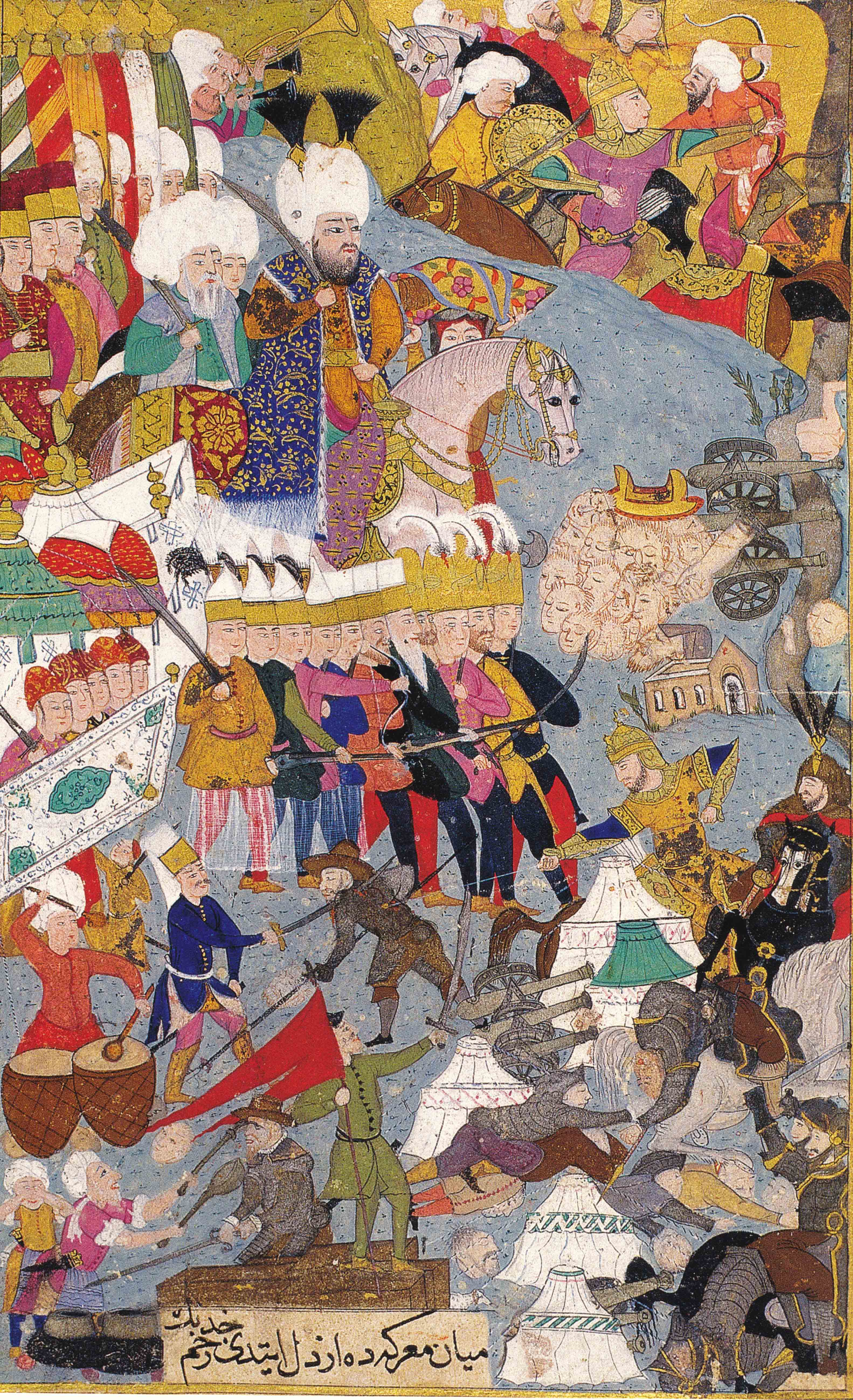
Hacova War, from the Divan of Nadiri (c. 1605; sourced from Osmanlı Resim Sanatı)
Fire is one of the chief images in miniatures (in addition to others, such as Chinese clouds, etc.), often seen in Ottoman-era manuscripts such as Ahval-i Kiyamet (The Conditions of Judgment Day), and Acaibül Mahlukat ve Garayibü’l Mevcudat (Ghazvini’s The Wonders of Creatures and the Oddities of Beings), where it, like fire in the context of carnivals, is ambiguous. In one form, fire represents the holy. The Prophet Muhammad and his kin, as well as all the prophets of Islam were portrayed with halos of fire around their heads, similar to the manner in which the ancient Persian kings were described in Ferdowsi’s Shahnameh (Book of Kings) as possessing the farr (a sort of divine recognition in the form of a halo). However, in a number of miniatures, the fire above the heads of various prophets were replaced with a white covering or rose pattern. The important thing to consider is that no figures aside from the prophets and their relatives were depicted in such a fashion.
In its second form, fire is a symbol of hell. Muhammad Visits Hell is a miniature that makes use of the vagueness of fire, as it employs fire imagery to depict both heaven and hell, as well as holiness and immortality in the same setting. The Prophet and his family with burning halos around their heads are praying for the people in hell, who are naked and being burned by fire blown from the mouths of strange creatures commanded by angels, evoking the imagery of the Sassanian-era Zoroastrian text, The Book of Arda Viraf. Transforming into a square, hell becomes a carnival with an integration of contrasts, exaggerated depictions, and masses of figures. Sin and virtue converge, and good embraces evil. As in a carnival, elements unconnected and far-flung come together in a single point in time and space.
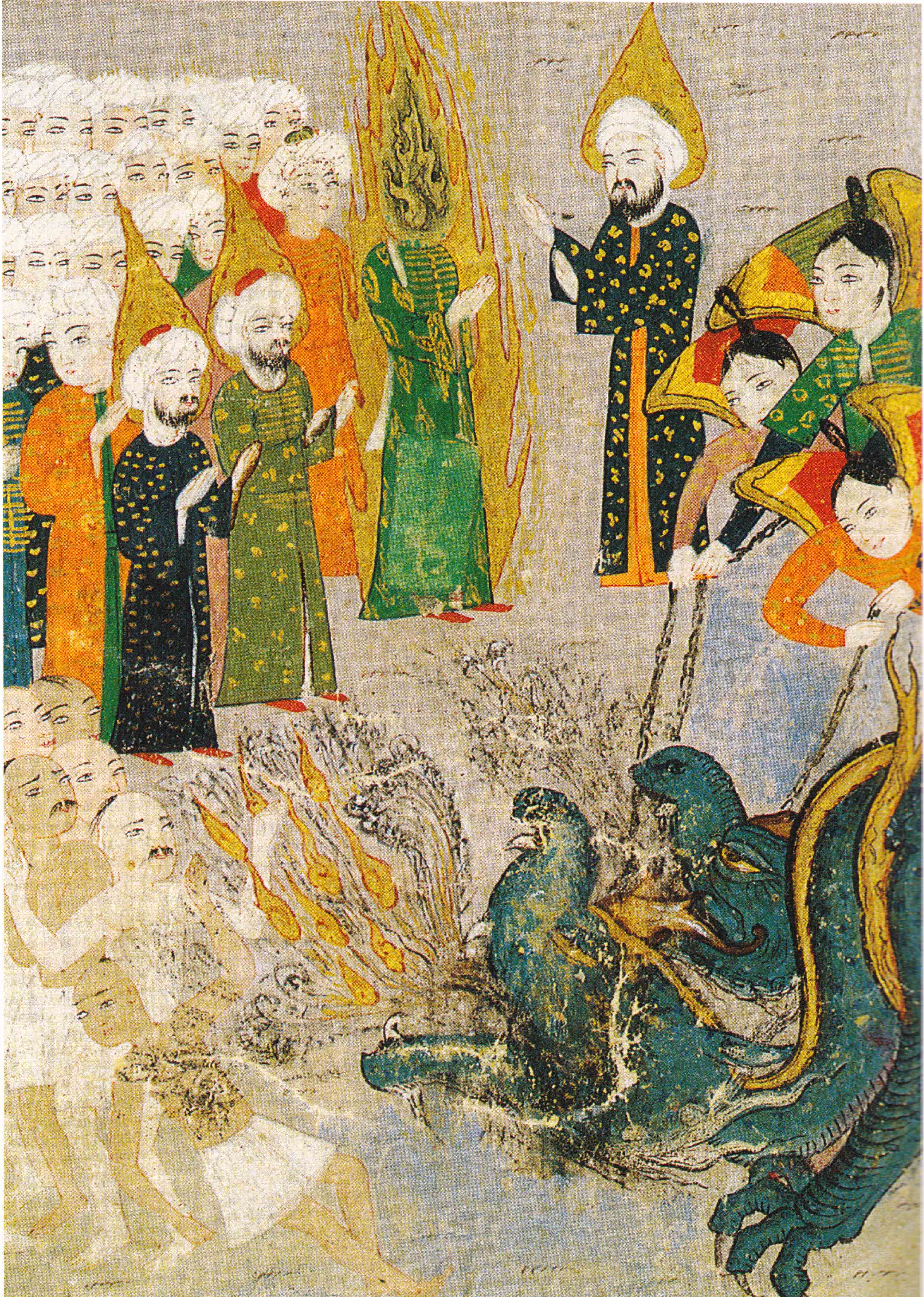
Muhammad Visits Hell, from the Ahval-i Kıyamet (1596; sourced from Minyatürlerle Osmanlı-İslam Mitologyası)
The End?
One of the reasons why miniatures are often universal sources of information and imagery rather than narrow-framed images particular to specific time periods is the carnivalesque feeling they generate. This opens new doors for audiences into upside-down realms where traditional storylines change, and a flamboyant imagery and dynamic, contrasting atmospheres abound. A clear correlation between the miniature tradition and the phenomenon of the carnival can be observed; however, to what extent they flourished on their own, or through cultural interaction is yet to be known. This article does not intend to analyse any cultural influences, or decipher them, but rather to better understand how miniature artists saw the world and depicted it, as well as observe how the spirit of the carnival seeped in through the margins of even one of the strictest and most traditional classical art forms.
